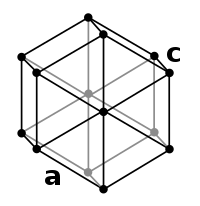
Photo from wikipedia
Herein for the first time, Ce0.184W0.07Ti0.748O2−δ nanofibers are prepared by electrospinning to serve as a catalyst in the selective catalytic reduction (SCR) process. The addition of cerium is proven to… Click to show full abstract
Herein for the first time, Ce0.184W0.07Ti0.748O2−δ nanofibers are prepared by electrospinning to serve as a catalyst in the selective catalytic reduction (SCR) process. The addition of cerium is proven to inhibit crystallization of TiO2, yielding an amorphous TiOx-based solid solution stable up to 500 °C in air, with supersaturated substitutional Ce. At higher temperatures, anatase phase (titanium oxide) is then observed along with fluorite (cerium oxide). Tungsten is instead demonstrated to promote the reduction of the Ce4+ to Ce3+ with the formation of oxygen vacancies (δ). Catalytic experiments under the best working conditions (dry and in the absence of SO2) are performed to characterize the intrinsic catalytic behavior of the new catalysts. At a temperature lower than 300 °C, superior NOx conversion properties of the amorphous TiOx nanofibers over the crystallized TiO2 (anatase) nanofibers are observed and attributed to higher specific surface area (SSA), larger amount of oxygen vacancies, and higher amount of Ce3+ over Ce4+. Comparison with literature data for ceria–tungsten-based nanoparticles also points out higher catalytic performances for the developed nanofibers at the lowest temperatures (<300 °C). This is mainly attributed to the unique nanofibrous morphology and to the doping approach. The stability of the amorphous Ce–W–TiOx nanofibers over time (120 h) and over a number of cycles (5) is demonstrated. Yet, superior catalytic performances of the developed catalysts in a wide range of temperatures (200–500 °C) over state-of-the-art material V–W–titania nanoparticles and nanofibers are also proven.
Journal Title: New Journal of Chemistry
Year Published: 2018
Link to full text (if available)
Share on Social Media: Sign Up to like & get
recommendations!